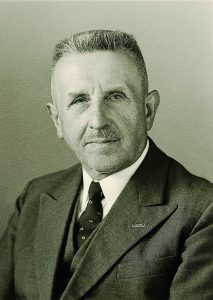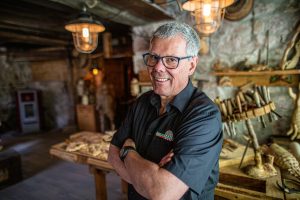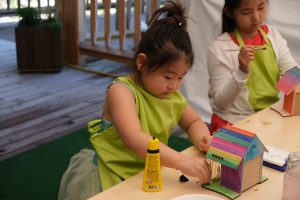Firmengeschichte


1881
Alles begann mit dem Uhrenschildmacher Josef Weisser (1807 – 1871). Dessen Sohn August Weisser (1828 – 1890) war ein selbständiger Uhrenkasten-Schreiner in Schönenbach bei Furtwangen. Im Jahre 1881 zog August Weisser mit seiner Familie nach Gremmelsbach bei Triberg. Dort ließ er sich einem kleinen Haus nieder und begann noch im selben Jahr mit der Herstellung von Schwarzwälder Uhrenkasten

1884
Im Jahre 1862 kam Ernst Weisser (1862- 1939) zur Welt. Er erlernte, wie sein Vater, den Beruf des Uhrenkasten-Schreiners und stieg schon früh in das Familienunternehmen ein.Ab 1884 führte er zusammen mit seinem Vater August das Geschäft bis zu dessen Tod und danach führten Sie es mit seinem Bruder Emil weiter.

1889
1889 erwarben August Weisser und Ernst Weisser ein Grundstück an der „Gutach“. Dort stand die notwendige Wasserkraft zur Verfügung, um einige kleine Maschinen über ein Wasserrad antreiben zu können. 1890 wurde mit dem Neubau der Uhrenkasten-Schreinerei begonnen. Im November 1890 starb August Weisser. Sein Sohn Ernst übernahm die Firma und führte diese alleine fort. Ab 1900 wurden zu den Uhrenkästen auch zunehmends fertige Uhren produziert.

1908
1908 brannte das erste Fabrikationsgebäude aus dem Jahre 1890 ab und wurde unverzüglich am selben Patz durch ein neues, größeres Gebäude ersetzt. Diesen Wiederaufbau bewältigten hauptsächlich Ernst Weisser und sein Sohn Wilhelm Weisser. Bis zum Ausbruch des 1. Weltkrieges florierten die Geschäfte und auch während des Krieges kam der Betrieb nicht vollständig zum Erliegen. Es wurde weiter fabriziert, soweit dies mit den vorhandenen Schreiner möglich war. Im Zeitraum 1920 bis zur großen Weltwirtschaftskrise war die Nachfrage nach Uhrenkästen, insbesondere aus England, riesengroß.

1930
Nach der Volksschule absolvierte Wilhelm Weisser (1887- 1983) zunächst in Triberg und später an der Großherzoglichen Schnitzereischule in Furtwangen eine dreijährige Lehre als Holzschnitzer. Von 1900 bis zum ersten Weltkrieg und in der Zeit danach arbeitete Wilhelm Weisser als Uhrenschnitzer und Uhrmacher in der Firma seines Vaters. 1930 wurde er als Teileigentümer von seinem Vater Ernst aufgenommen. Nach dessen Tod leitete Wilhelm Weisser die Firma über die Zeit des zweiten Weltkrieges hinweg.

1932
1932 verlegte Wilhelm Weisser das Musterzimmer und den Verkaufsraum für die fertigen Uhren vom Dachgeschoss der Schreinerei in ein Nebengebäude der Uhrenkastenfabrik. Dies war für die Kundschaft besser zugänglich. Hinzu kamen dann schnell Reiseandenken und ein Uhren-Versandhandel. Den Handel mit fertigen Uhren baute Wilhelm Weisser im Laufe der Jahre aus und betrieb diesen auch noch viele Jahre nach seiner Pensionierung mit Hilfe seines Sohnes Lothar. Mit 68 Jahren erreichte Wilhelm Weisser das Rentenalter und verpachtete das Geschäft, da sein Sohn Lothar noch mitten in der Ausbildung stand.

1968
Während die eigentlichen Firmengebäude verpachtet waren begann Lothar Weisser (geboren 1935) Ende der sechziger Jahre als junger Techniker in den Kellerräumen im Ladengeschäft seines Vaters Wilhelm mechanische Uhrenteile für eine Triberger Uhrenfabrik zu produzieren. Nach Ablauf der Pachtverträge übernahm Lothar Weisser wieder das Fabrikgebäude der Familie und verlagerte den Uhrenhandel in die Räumlichkeiten der Fabrik. Die Produktion von Uhrenkästen wurde nicht mehr fortgeführt. Fortan lag der Schwerpunkt auf dem Handel, die Produktion wurde nicht gänzlich aufgegeben, trat aber in den Hintergrund.

1973
Um das Verkaufsgeschäft kümmerte sich zunächst Lothars Frau Hildegard Weisser, während Lothar Weisser weiter Uhrenteile produzierte. 1973 wurde der Schwerpunkt ganz auf den Handel mit Schwarzwälder Uhren verlegt. Die Räumlichkeiten der ehemaligen Uhrenkasten-Schreinerei wurden in mehreren Stufen ausgebaut. Der internationale Tourismus im Schwarzwald entwickelte sich zunehmends. Die Schwarzwälder Kuckucksuhr gewann wieder weltweit an Ansehen und entwickelte sich zu einem wichtigen Wirtschaftsgut für die Region. In dieser Zeit wurde von Lothar und seiner Frau Hildegard Weisser eine neue Ära in der Firmengeschichte eingeläutet. Die Ära des bis heute legendären „Haus der 1000 Uhren“.

1982
Aus der ehemaligen Uhrenkasten-Schreinerei der Großväter entstand in mehreren Umbauphasen das „Haus der 1000 Uhren“, das in seinem Aussehen und in seiner Form bis heute besteht. Moderne, schwarzwaldtypische Geschäftsräume wurden geschaffen, in denen die ganze Vielfalt und Tradtion an Schwarzwälder Uhren einer breiten internationalen Kundschaft angeboten wird.

1984
In Triberg, in unmittelbarer Nähe zum Wasserfalleingang, wurde ein weiteres „Haus der 1000 Uhren“ eröffnet, direkt im Stadtzentrum.

1986
Ein ehemaliges Gasthaus und bisher nur für Lagerzwecke genutztes Gebäude wurde zum Geschäft umgebaut. Hier fanden auch die Uhrmacherwerkstatt und die Versandabteilung ihren neuen Platz.

1996
1996 gab Lothar Weisser die Gesamtverantwortung an seinen Sohn Thomas ab. Thomas Weisser (geboren 1962) erlernte zuerst den Beruf des Werkzeugmachers, später kam eine kaufmännische Ausbildung hinzu. Schon seit Kindesbeinen ist er im Unternehmen seines Vaters tätig. Neue Phasen der Erweiterung und Modernisierung standen bevor und wurden zusammen mit seiner Frau Rebecca in Angriff genommen.

1997
Das Geschäftshaus in Tribergs Stadtmitte war zwischenzeitlich viel zu klein geworden. Triberg verzeichnete an Deutschlands höchsten Wasserfällen inzwischen mehr als 400.000 Besucher pro Jahr aus vielen Ländern der Erde. In dieser Zeit wurde die größte Investition der Firmengeschichte getätigt. Die Flächen der Geschäftsräume wurden nahezu vervierfacht und das Geschäft ist nach wie vor der größte Standort innerhalb der Firmengruppe. Teilweise mussten die Räumlichkeiten sogar in den bergwärts vorhandenen Felsen gesprengt werden. Der Innenausbau wurde völlig neu konzipiert und den heutigen Anforderungen angepasst. So haben unsere Kunden heute die Möglichkeit die ganze Vielfalt an Schwarzwalduhren und Geschenkartikeln in einem einzigartigen Ambiente zu erleben.

2006
2006 bekam unsere „Haus der 1000 Uhren“-Familie Zuwachs. Der TRIBÄR wurde geboren. Eine äußerst liebenswerte Uhrmacherfamilie, die aus folgenden Mitgliedern besteht: Der TRIBÄR Papa, der als Uhrenträger die Fassade hoch und runterklettert. Die TRIBÄR Mama – die gute Seele der Familie – die ihrem Mann zum Abschied winkt, wenn er auf seine langen Reisen geht. Der TRIBÄR Opa bleibt zuhause und montiert in aller Liebe seine Schwarzwalduhren. Die TRIBÄR Tochter schaukelt vergnügt und unbeschwert und beobachtet, was die restlichen Familienmitglieder so alles treiben. Zu jeder viertel Stunde setzt sich die ganze Familie in Bewegung und ist inzwischen zu einer vielbestaunten Attraktion am „Haus der 1000 Uhren“ in Triberg geworden. Das Orginal „Haus der 1000 Uhren“ – nur echt mit dem TRIBÄR!

2012
Neben den Ladengeschäften in und um Triberg wurde 2012 der Haus der 1000 Uhren Online Shop ins Leben gerufen. Dies war der Startpunkt für die Erweiterung der Verkaufskanäle in die digitale Welt. Kunden aus aller Welt hatten fortan die Möglichkeit Kuckucksuhren aus dem Haus der 1000 Uhren zu bestellen und direkt zu sich nach Hause schicken zu lassen.

2016
Im Jahr 2016 wurde in einem ersten Bauabschnitt unser Haus „Forelle“ um eine große Terasse und eine Brücke über die Gutach erweitert. Außerdem wurde eine Uhrmacher Szene mit beweglichen Figuren an der Terrasse angebracht, die die Herstellungsschritte der Kuckucksuhr zeigt. Für unsere Besucher bietet dies eine geniale Möglichkeit die Schwarzwälder Natur und den Bachlauf sowie ein Stück Handwerkstradition zu genießen.

2018
Ein neuer Geschäftszweig erhält Einzug in das Haus der 1000 Uhren: Gruppen und Besucher aus aller Welt hatten erstmals die Möglichkeit bei einer Führung durch die freigelegte historische Werkstatt der Familie Weisser die Schnitz- und Handwerkskunst der Kuckucksuhr hautnah zu erleben, sowie in einem Workshop die ganz eigene Kuckucksuhr zu bemalen und gestalten. Durchgeführt werden diese Veranstaltungen am Standort Forelle.

2019
In 2019 wurde die erste Virtual Reality Applikation des Haus der 1000 Uhren fertiggestellt. Durch VR können Nutzer in der historischen Werkstatt die Herstellungsschritte der Kuckucksuhr durchführen – vom Aussägen und Schnitzen über das Montieren der Uhr bis hin zur farblichen Gestaltung.

2020
In 2020 wurden währen der Corona Krise sämtliche kreativen Möglichkeiten genutzt, um mit der weltweiten Kundschaft in Kontakt zu bleiben und neue Wege der Kommunikation und des Verkaufs zu nutzen. So wurde unser Ladengeschäft in 360-Grad aufgenommen und Nutzer konnten durch den virtuellen Rundgang auch aus der Ferne das Haus der 1000 Uhren in Triberg besuchen. Zudem wurden neue Content Formate geschaffen wie das Haus der 1000 Uhren TV. In diesem Format wurden Kurzvideos zu unseren Produkten und Themenwelten von unseren Mitarbeitern aufgenommen und veröffentlicht. Eine Videoberatung wurde für unsere Kunden ins Leben gerufen, sodass auch aus der Ferne ein persönlicher Kontakt und eine persönliche Beratung vor Ort hergestellt werden konnte. Digitale Shopping Kanäle wie der Webshop aber auch die Sozialen Medien wurden ausgebaut. Ein neuer Schub der digitalen Customer Experience, der bis heute ergänzend zu den Ladengeschäften Bestand hat.


2022
Die Geschwister Sarah und Matthias Weisser steigen in das Familienunternehmen ein und arbeiten Seite an Seite mit ihren Eltern Thomas und Rebecca Weisser im Unternehmen – und stellen somit die 6. Generation der Familie Weisser im Uhrengeschäft dar.
Sarah Weisser hat nach ihrem International Management Studium externe Berufserfahrung in der Unternehmensberatung in Frankfurt gesammelt. Diese Erfahrung bringt sie in das Familienunternehmen mit ein und wird dieses in 6. Generation in der Geschäftsführung weiterführen.
Matthias Weisser hat eine Ausbildung zum Werkzeugmechaniker absolviert und ebenfalls externe Berufserfahrung gesammelt, bevor er in das Familienunternehmen in der Rolle des technischen Leiters einstieg.

